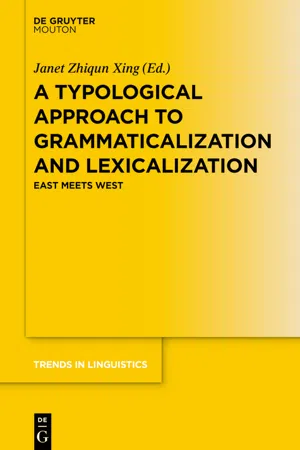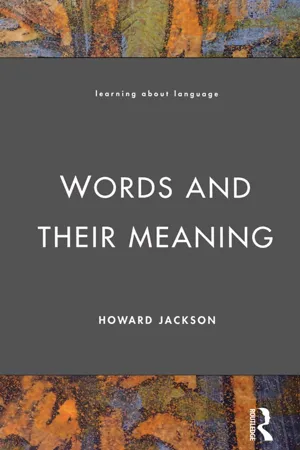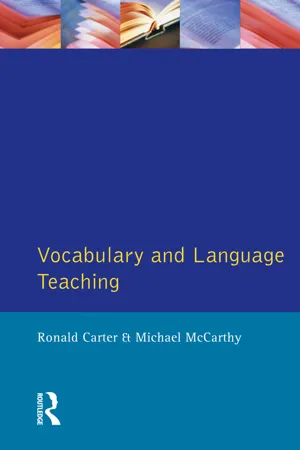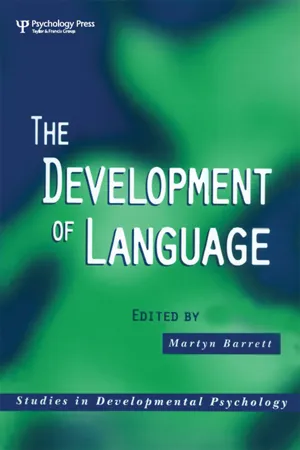Compound Words
Compound words are formed by combining two or more words to create a new word with a distinct meaning. These words can be formed through various processes, such as combining two nouns (e.g., "toothbrush"), a noun and an adjective (e.g., "blackboard"), or a verb and a noun (e.g., "breakfast"). Compound words are prevalent in many languages and play a significant role in vocabulary expansion.
7 Key excerpts on "Compound Words"
- eBook - ePub
- Janet Zhiqun Xing, Janet Zhiqun Xing(Authors)
- 2020(Publication Date)
- De Gruyter Mouton(Publisher)
...Firstly, the elements that make up compounds in some languages are not free-standing words, but rather stems or roots. Secondly, it is not always easy to make a clean distinction between compounds on the one hand and derived words or phrases on the other. The criteria for distinguishing between a syntactic construction and a compound are not well established. Possible criteria proposed so far include phonological (stress, vowel harmony, the sandhi process, tonal pattern s, vowel deletion or reduction, etc.), morphological (the behavior of the compound with respect to inflection, presence of linking elements or special formatives, the loss of syntactic dependency markers, special constituent order), syntactic (syntactic impenetrability, inseparability, and inalterability), semantic (non-compositionality, degree of lexicalization or listedness in the lexicon), and orthographic (written as a single orthographic word). 1 None of these are foolproof or cross-linguistically applicable but language-specific. The study of compounds involves many aspects and issues, including, but not limited to, headedness, exocentricity, productivity, the lexical category of the constituents (and the whole compound as well). The grammatical and semantic relationships of the constituents, and thus the classification of the whole compound, along with the relationship between compounding and other morphosyntactic phenomena such as incorporation, serial verbs, phrasal verbs, and the like complicate their study as well. As a type of word formation, the process of compounding, as revealed by some recent studies such as Lehmann (2002), Packard (2004), Brinton and Traugott (2005), Lightfoot (2011), Wischer (2011), among others, can be closely interrelated with the processes of lexicalization and/or grammaticalization...
- eBook - ePub
- Howard Jackson(Author)
- 2014(Publication Date)
- Routledge(Publisher)
...For example, the noundouble-glazingis a compound formed from the adjectivedoubleand the present participle (verbal noun)glazing; the nounmotorwayis formed from the two nounsmotorandway, the noungobstopperis formed from the noungob(a slang word for mouth, borrowed from Gaelic) and the deverbal nounstopper(i.e. derived from the verbstop). Most compounds are nouns; they are coined because there is a need to ‘name’ an object or thing that has not been named before. And because the meaning of a compound is usually transparent (i.e. it can be deduced from the meanings of the words from which it is formed), it readily commends itself to acceptance by the speakers of the language. Not all compounds are nouns; indeed most word-classes may contain compounds, e.g.overcharge(verb),lacklustre(adjective),outside(adverb),into(preposition),yourself(pronoun).There is another kind of compounding, in which the parts of the compound are not themselves independent words. These are compounds formed from the Latin and Greek loan-words that we mentioned earlier. In a word likebibliography, for example, neitherbiblio-nor-graphyare words in English, though they are, with suitable inflections, in Latin or Greek, with the meanings ‘book’ and ‘writing’ respectively. We refer to these compounds as ‘neo-classical’ compounds, and to their parts as ‘combining forms’. Many scientific and academic words continue to be coined using the combining forms borrowed from Latin and Greek, such asbio-, electro-, tele-, -ology, -phile, -scope.Another highly productive process by which new words are coined isderivation. Derivation involves adding to an existing word either a suffix (at the end) or a prefix (at the beginning). Suffixes and prefixes, known collectively as affixes, may not stand alone as words; they occur only in combination with a word...
- eBook - ePub
Second Language Processing
An Introduction
- Nan Jiang(Author)
- 2018(Publication Date)
- Routledge(Publisher)
...Chapter 5 Processing Complex Words, Multiword Units, and Meanings in L2 5.1 Introduction The study of L2 word recognition reviewed in Chapter 4 deals with words as individual whole units. L2 lexical processing research has also considered the processing of complex words and multiword units such as formulas and col-locations. Complex words are words with more than one morpheme. Three types of complex words are usually distinguished: inflected, derivational, and Compound Words, such as walked, unhappy, and classroom. They differ in how morphemes are combined in their creation. The inflectional and derivational words are created by adding inflectional and derivational affixes to a root, and a compound is made of two free morphemes. Several types of multiword units can be distinguished as well even though they are not always clearly defined and differentiated in the literature. They may include formulaic expressions (or simply formulas) such as on the other hand, lexical bundles such as the end of the, collocations such as on foot and by car, and idioms such as beat around the bush. Investigations into these lexical units have attempted to answer a common research question: are they represented holistically or in a decomposed way? For example, is the word unhappy stored in our lexicon as a single unit or as two units, i.e., un and happy ? Similarly, is the expression on the other hand stored as a whole unit or as four individual words? Other questions have also been explored such as how L2 proficiency, semantic transparency (i.e., whether the meaning of a compound is the combined meanings of its two component words, e.g., classroom being transparent and honeymoon being opaque), cross-linguistic congruency (i.e., whether an L2 collocation has a counterpart in L1) affect their representation and processing. Furthermore, lexical processing research has examined how lexical meaning is represented and processed in an L2...
- eBook - ePub
English Words
Structure, History, Usage
- Francis Katamba(Author)
- 2015(Publication Date)
- Routledge(Publisher)
...lexical items). As we saw in section (4.4.4) where we discussed compounds, many words have meanings that are compositional. Compositionality means that the semantic interpretation of a complex semantic unit is predictable from the meaning of its parts. Morphology and the lexicon need to be equipped with rules that allow the creation and analysis of any word that is compositional. If that is done, it is not necessary to list the meanings of words like smok-er, iron-ing, prearrang(e)-ed and farm-labour-er, for the meanings of these words can be computed from the meanings of their parts. By the same token, it is not necessary for speakers to memorise the meanings of such words. They can just work them out. In the theoretical framework that we are using, morphology is part of the lexicon. The lexicon is not a passive list of words and their meanings. It is not simply like an anatomy laboratory where existing words are dissected on a slab into their constituent morphemes and examined under a microscope. No, in this theory the lexicon is much more than that. It is also a place full of vitality where rules are used actively to create new words. To perform this function, the lexicon must include in dictionary entries these types of information about each simple word and each morpheme: [5.1] its meaning its phonological properties its syntactic properties its morphological properties. The reasons for including these kinds of information in dictionary entries will be made clear below. 5.2 Morphological information in the lexicon The lexicon needs to contain various kinds of morphological information. Words behave differently in the language depending on the morphological subclasses they belong to. For instance, morphological rules often apply to words marked as belonging to specified subclasses...
- eBook - ePub
Applying Linguistics in the Classroom
A Sociocultural Approach
- Aria Razfar, Joseph C. Rumenapp(Authors)
- 2013(Publication Date)
- Routledge(Publisher)
...They are easy to see in writing because of the spaces we put in between them, but in rapid speech, they are not always so easy to identify. Sometimes we slur words together; sometimes we drop off parts of words. When we are teaching students about words and our focus is the ‘words’ themselves, then we might be losing sight of the more critical element: meaning. This is a tough balance to hold, for we want our students to attend to the typical speech style of, say, mainstream American English, but we also want them to develop competence in meaning, developing ideas, and effectively communicating them. Therefore, this chapter is really organized to help us understand how many of the overlooked processes in language-use demonstrate a linguistic competence on the part of our students that is not seen if they are only evaluated from the point of view of Standard American English. In fact, many of the “mistakes” our students make actually may provide us with deep insight into language learning. Morphemes and Morphological Analysis In linguistic talk, a “morpheme” is the smallest unit of language that is meaningful. In written language we can see words, either like the ones you are reading now or characters as in Chinese or hieroglyphics. There are conventional spellings or pictograms for those words, and we can recognize them when we see them. However, in spoken language, words work a little differently. In fact, there are multiple language systems that use morphemes in a variety of ways. In English, for example, each word consists of at least one morpheme, but many words contain several morphemes. Think of the word “cat.” When we teach our students to make this word plural we tell them the English rule is to add an “-s” to make “cats.” This basic rule is an example of how English combines two morphemes into one word. The first morpheme is “cat” which we, in English, identify as a noun. The second is the plural marker, which we can add to most nouns to make plural...
- eBook - ePub
- Ronald Carter, Michael Mccarthy(Authors)
- 2014(Publication Date)
- Routledge(Publisher)
...To understand what is meant by this, it may be worth considering an age-old distinction drawn by linguists and philosophers, one which most language teachers work with constantly, in however diluted a form. Ever since the time of the Ancient Greeks, a crude distinction has been made between words which have independent meaning and words which have no independent meaning, but which structure the meanings of combinations of the other words. Notwithstanding disputes as to exactly where the boundary lies between the two types of words, this distinction has come down through the ages and is firmly entrenched in modern theoretical and applied linguistics (surveys of the issue may be found in Carlson 1983 and Carlson and Tanenhaus 1984). The centuries of debate have provided different labels for the two types of words, but the distinction is fairly consistent. Words with independent meaning are variously called lexical, vocabulary, content, full, contentive or open-system words. Words which structure the other words in texts are called grammar, function, empty, closed-system, functor or form words. The first group comprises the bulk of the lexicon of a language like English; the second group includes articles, prepositions, pronouns, auxiliary verbs, etc. Such a fundamental division of the words of a language between grammar and lexis is a very powerful one, and most language-teaching texts hinge on it. It is a commonsense division and it has served us well, but there are problems. Firstly, the division between lexical words and grammatical words is by no means as clear-cut as may seem at first glance. Secondly, recent research in text and discourse analysis shows that whole classes of words over and above the grammar words seem to be doing jobs in texts comparable to those the grammar words have always been held to do, and that such words have less independent meaning than might be expected...
- eBook - ePub
- Martyn Barrett(Author)
- 2016(Publication Date)
- Psychology Press(Publisher)
...Firstly and most obviously, the words which make up the sentence contribute to its meaning. Therefore, if a word in a sentence is changed, the meaning of the sentence changes: 1. The boys played soccer. 2. The boys played cricket. In fact, from a semantic point of view, the word itself is not always the smallest unit of meaning in a sentence. For example, in the above sentences, the word boys actually contains two meaning units, boy and - s, where the - s contributes the meaning that more than one boy played the game. Similarly, the word played consists of two meaning units, play and - ed. These smallest units which contribute to the meaning of the sentence are called morphemes rather than words. Some morphemes, such as boy, play, etc. can be used on their own; these are called free morphemes. Other morphemes, such as - s and - ed, cannot be used on their own; these are called bound morphemes. Sometimes, several bound morphemes can be attached simultaneously to a single free morpheme; for example, the word untimeliness contains four morphemes (cf. time, timely, untimely, untimeliness). The study of morphemes, and of how morphemes are combined with one another to form larger word structures, is called morphology (Matthews, 1974). However, not all words that contain multiple meaning components can be decomposed into individual morphemes as simply as the above examples suggest. For example, the word ran is related to the word run, and this relationship is similar to that between played and play, but ran cannot be decomposed into two morphemes in the same way as played. The situation is further complicated by the fact that the term “word” itself is actually ambiguous. Thus, we can say that the words found and find are two different words, but at the same time we can say that they are both different forms of the same underlying word...






